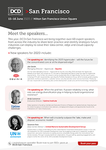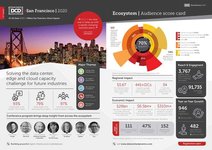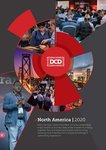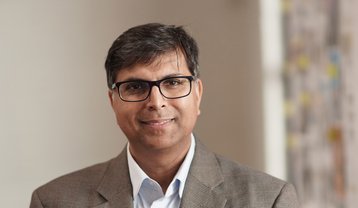Ahead of DCD>San Francisco, Rajan Battish, Principal, RSP Architects sat down for a Q&A with DCD’s Kisandka Moses, who is producing this year’s conference, to discuss some of the key trends in critical infrastructure emerging from the COVID-19 pandemic.
Q: The world has changed immeasurably since the outbreak of the coronavirus, prompting unprecedented strain on the network and spikes in internet traffic. How has the generation and delivery of critical power to digital infrastructure evolved over this period?
A: There's been an increase in desire to maintain uptime for a lot of our clients, we're seeing clients that are not just in the cloud, but also, our corporate clients, who are more cautious about having any changes to their infrastructure for data centers or IT connectivity. We have a client with a hospital nearby, and they had an immense need to upgrade the UPS system which was a project they had on hold but because of the nature, or how critical it is for them to rely on IT equipment to provide compete for the hospital, they have since accelerated the upgrade to boost resilience of critical power. The resiliency aspect is increasing attention from senior management at universities also, where we see high demand for e-learning and migration to online applications. In hospitals, which are relying on the IT locally and regionally to provide access to the patient's information, prior to the outbreak these projects were typically overheads for a lot of these clients, who now look at them as a central function. The [modernization and upgrading of] critical infrastructure becomes a little more palatable to them given the surge in demand which is not likely to decrease.
More on DCD>San Francisco
-

DCD>San Francisco 2020 Meet The Speakers
See which industry-leaders are sharing their expertise at the West Coast's leading data center & cloud infrastructure event
-

DCD>San Francisco 2020 Audience Scorecard
See who you can expect to meet onsite at the west coast's leading data center & cloud infrastructure event
-

DCD>North America 2020 Events Guide
Take an in-depth look at the audiences at our North American events
Q: How has the ‘work from home’ culture permeated the industry? Have you witnessed any material changes in terms of operations which may be here to stay once ‘stay in place and shelter’ mandates are lifted?
Yeah, we are seeing quite a bit of that. A lot of our clients have very strict guidelines regarding access to data center projects and construction sites. I went to a site recently and was mandated to use gloves and a mask. There was a limited number of people that could join the walkthrough and be brought onto the project site. We do not have any temperature sensors yet, but we expect that to happen in the near future as well, and an extra level of security to verify which is critical in accessibility to any project site. Currently, in the United States, if you need to leave the state you reside in and go to a private data center site, you are mandated to quarantine in a private residence upon your arrival back to your state.
We are essential workers and as a result we're very cautious about how many personnel we send out of state, how many can attend the job site and what protection we're providing for those people. If we can minimize the number of people on-site then we believe that's the best way to create social distancing.
Q: The revenues of colocation and public cloud providers are largely stable, but the same cannot be said for a number of large enterprises with sizable data center stock. Is there any concern that businesses at large may place the issue of sustainability on the backburner, in favour of investment in prized land, build, personnel and critical infrastructure?
A: From my experience, if it makes economic sense to pursue sustainability, then owner-operators will do it, irrespective of their investments in land and so forth. This means that sustainability is going to continue to be a priority for some clients who will continue to invest. If you look at some of the facility designs we're seeing out there in the marketplace for both hyperscale cloud and corporate, enterprise clients, they're all looking at efficiency, and how to reduce the carbon footprint and benefit out of it. The key consideration is ‘how do we reduce energy costs in our data centers and critical infrastructure and how do we minimize the cost to operate it. How do we simplify the design so that it has less components to operate and maintain. These considerations tie into sustainability. People usually associate sustainability with solar panels and wind power, but reducing the number of components and buying less is an important factor in being environmentally friendly. A lot of our clients do not use UPSs anymore which is great as it means there is an alternative way to design critical infrastructure. To me, this is sustainable.
Q: You will provide a case study at DCD>San Francisco focused on innovation in backup power - battery storage to be specific. You made the claim that generators and UPSs are not a critical need for digital infrastructure - is this true for large as well as smaller data center operators?
A: If you look at colocation and the hyperscale data centers, a lot of top clients are migrating away from the traditional UPS technology. For me, backup generation is another challenge we're faced because the environmental impact of these solutions needs to be developed to meet the requirements of hyperscale-size deployments. You have a 300 megawatt data center and have idle 2MW generators lined out throughout a facility, it just does not sound practical and economic sense. We are actually doing a concept study right now for a hyperscale project in Northern Virginia where we're looking at deploying a combination of various storage systems including flash medium voltage UPS with a combination of either CHP or a version of on-site generation to help provide power quickly to the data center site. In a facility of that scale, you need 200-300 MWs and this amount of power is not readily available on the traditional utility grid and as a result a hybrid solution is required to meet those demand requirements. I believe that the distributed generation is going to be a great segue into an hyperscale project, because of the additional speed needed to get the power that you need for the data center, and also the added ability you will get from on-site generation. The combination of CHP batteries or systems and a utility is definitely a way to achieve a higher level medium voltage type UPS which is perfect for hyperscale needs.
Rajan will join us at DCD>San Francisco on the 15-16 October 2020, to present on: “No generator, no UPS, no problem - Can innovative battery storage save the planet?”

